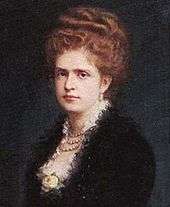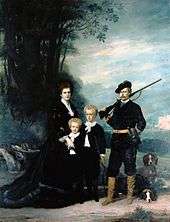Joseph Layraud
Joseph Fortuné Séraphin Layraud (15 October 1834 – 12 October 1912) was a French painter. There is no complete clearance as to the birth' and the death' dates. Some sources refer to 1833-1913.[1][2] His range included historical scenes and figures, religious and mythological subjects, landscapes, and portraits of contemporaries.[3]
Life and career


Layraud was born at La Roche-sur-le-Buis in south-eastern France. After beginning his training in Marseilles in 1853 he moved to Paris in 1856, studying at the École nationale supérieure des Beaux-Arts under Léon Cogniet and Tony Robert-Fleury. He was awarded the Grand Prix de Rome in 1863.[4]
After his time in Rome, Layraud travelled in Italy and Portugal, painting landscapes, he did some history paintings and many portraits.[3] From 1892 he was a professor at the Académie des beaux-arts in Valenciennes. His pupils included Jules Chaine, Max Albert Decrouez, Grégoire Nicolas Finez, Lucien Hector Jonas, Charles Paris, Maurice Rufin and Alfred Léon Sauvage.[4][5]
Layraud exhibited at the Paris Salon, winning medals in 1872; his work was shown at the 1889 and 1900 Expositions Universelles.[4]
Layraud was appointed Chevalier of the Légion d'Honneur in 1890 and was promoted to Officer in 1903. He died 1913 on his birth day, in Valenciennes.[4]
Works
Layraud's works are on show in French galleries in:
- Avignon (Doctor P E Chauffard)
- Bayonne (Femme au chapeau noir)
- Cahors (portrait of Léon Gambetta)
- Chambery (Le bon Samaritain)
- Épinal (Marsyas Flayed)
- Narbonne (Diogenes)
- Paris
- Musée d'Orsay (Chambre mortuaire de Gambetta)
- École nationale supérieure des Beaux-Arts (Joseph se fait reconnaître par ses frères)
- Troyes (vue de Lisbonne prise de la rive gauche du Tage; vue du Tage prise du palais de l'ambassade de France)
- Valence (Joseph se fait reconnaître par ses frères), (Wreck of the Medusa; Mgr Catton; Inès de Castro)
The Musée des beaux-arts of his adopted city, Valenciennes, holds many works by Layraud, including Bulls Brought Out and many portraits of which that of Liszt is among the best known.[4][6]
Internationally, Layraud's work is displayed in Melbourne (Italian Highwaymen), the Ajuda National Palace,[4] and Smith College Museum of Art, Massachusetts (Portrait de Pierre Dupont).[7]
Notes
- Layraud 1833/1913 - Pairs of notable portraits - French School of the nineteenth dated 1855/ Joseph Layraud 1833/1913 - Pairs of notable portraits - French School of the nineteenth dated 1855 Retrieved on 13 Jan 2018
- de personne.Layraud, Fortuné (1833-1913) Retrieved on 13 Jan 2018
- "Layraud, Joseph Fortuné Séraphin" Retrieved on 12 Jan 2018
- "Layraud, Joseph Fortuné Séraphin", Benezit Dictionary of Artists, Oxford Art Online, Oxford University Press, retrieved 19 July 2014 (subscription required)
- "Layraud", Benezit Dictionary of Artists, Oxford Art Online, Oxford University Press, retrieved 19 July 2014 (subscription required)
- "Joseph Layraud", Joconde – Portail des collections des musées de France
- portrait de Pierre Dupont Smith College Museum of Art, Northampton